EMC Question of the Week: July 10, 2023

Which type of induced transient in an EMC compliance test generally has the greatest time-rate-of-change in voltage (i.e., the highest dV/dt)?
- ESD
- EFT
- damped sinusoid
- lightning
Answer
The best answer is “a.” An ESD transient induced on a circuit board trace can go from 0 to several thousand of volts in less than a nanosecond. This is a dV/dt on the order of 1013 V/s. An Electrical Fast Transient (EFT) has a voltage time-rate-of-change that is nearly as high, potentially going from 0 to several thousand volts in several nanoseconds (on the order of 1012 V/s). Damped sinusoids (per MIL-STD-461G CS116) can rise to about 100 volts in a few nanoseconds at the highest test frequencies (a dV/dt on the order of 1011 V/s). Induced lightning transients (per IEC 61000-4-5) go from 0 to 4000 volts in a few microseconds (a dV/dt on the order of 109 V/s).
Note that the waveform induced in the equipment under test can look much different than the calibration waveform published in the test standard. The induced waveform depends on several factors including the method of coupling and the impedance of the victim circuit.
Lightning transients carry much more energy than ESD or EFT transients. EFT transients are generally applied in bursts and carry more energy than ESD transients. When selecting an appropriate transient protection device, it is important to choose a device that is both fast enough and able to handle the transient energy without breaking. Other important considerations are the turn-on voltage, shunt capacitance, polarity, size and cost.
Today, it is relatively easy to find custom transient protection devices for many standard power inputs and high-speed digital interfaces. These devices often integrate several components into a low-inductance, low-cost package.
Have a comment or question regarding this solution? We'd like to hear from you. Email us at
